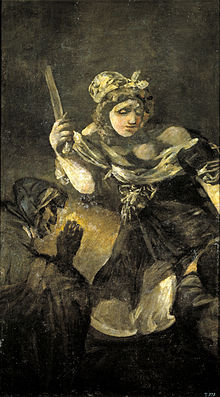art.wikisort.org - Painting
Judith and Holofernes is the name given to one of the 14 Black Paintings painted by Francisco de Goya between 1819 and 1823. By this time, Goya was in his mid 70s and deeply disillusioned. In mental and physical despair, he painted the private works on the interior walls of his home—applying oils directly on plaster[1]—known as the Quinta del Sordo ("The House of the Deaf Man"), which he had purchased in 1819. Judith and Holofernes was likely painted on the first floor, beside Saturn Devouring His Son.[2] The picture is a personal reinterpretation of the narrative of the Book of Judith, in which the protagonist saves Israel from the assault of the general Holofernes by seducing and beheading him. Judith is the only historical figure who can be identified with certainty among the Black Paintings. [citation needed]
| Judith and Holofernes | |
|---|---|
| Spanish: Judith y Holofernes | |
 | |
| Artist | Francisco de Goya |
| Year | 1819–23 |
| Type | Oil mural transferred to canvas |
| Dimensions | 143.5 cm × 81.4 cm (56.5 in × 32.0 in) |
| Location | Museo del Prado, Madrid |
Judith and Holofernes' palette consists of blacks, ochres and red applied with very free, broad and energetic brushstrokes. The lighting is both focused and highly theatrical, and seems to imply a night scene lit by a torch, which illuminates Judith's face and outstretched arm and leaves in semidarkness the face of the old serving woman whose darkened outline is shown in prayer. Significantly, neither Holofernes nor the blood streaming from his neck is shown, as is typical of most artistic renderings.
Given Goya's bitter disillusionment over the second restoration of Ferdinand VII, it is possible that Holofernes represents the Spanish King, whom Goya privately despised. Holofernes' death was often depicted in art as a symbol of the defeat of tyranny. This would have been a brave and daring allusion for an artist with such ties to the crown as Goya had. Goya did not believe, however, that the series would ever be viewed by anyone but himself, which allowed him greater freedom of expression.[3] He had been secretive before when delivering unpalatable political views through his work; his Disasters of War series of etchings harshly comments on both the Peninsular War and the later Bourbon Restoration, but was only published 35 years after his death.[4]
Along with the other works in the series, the painting was transferred to canvas in 1873–74 for Baron Émile d'Erlanger under the supervision of Salvador Martínez Cubells, a curator at the Museo del Prado. D'Erlanger donated all 14 canvases to the Prado in 1881.[5]
See also
- List of works by Francisco Goya
Footnotes
- Hughes, 16
- Fernández, G. "Goya: The Black Paintings". theartwolf.com, August 2006. Retrieved 4 April 2010.
- Hughes, 379
- Jones, Jonathan. "Look what we did". The Guardian, 31 March 2003. Retrieved 4 April 2010.
- Hughes, 16–17
Bibliography
- Benito Oterino, Agustín, La luz en la quinta del sordo: estudio de las formas y cotidianidad, Madrid, Universidad Complutense, 2002, p. 33. Edición digital ISBN 84-669-1890-6.
- Bozal, Valeriano, Francisco Goya, vida y obra, (2 vols.) Madrid, Tf. Editores, 2005. ISBN 84-96209-39-3.
- Bozal, Valeriano, Pinturas Negras de Goya, Tf. Editores, Madrid, 1997.
- Glendinning, Nigel, Francisco de Goya, Madrid, Cuadernos de Historia 16 (col. «El arte y sus creadores», nº 30), 1993.
- Hagen, Rose-Marie and Hagen, Rainer, Francisco de Goya, Cologne, Taschen, 2003. ISBN 3-8228-2296-5.
- Hughes, Robert. Goya. New York: Alfred A. Knopf, 2004. ISBN 0-394-58028-1
External links
 Media related to Judith y Holofernes (Goya) at Wikimedia Commons
Media related to Judith y Holofernes (Goya) at Wikimedia Commons
На других языках
- [en] Judith and Holofernes (Goya)
[es] Judith y Holofernes
Judith y Holofernes es una de las Pinturas negras que formaron parte de la decoración de los muros de la casa —llamada la Quinta del Sordo— que Francisco de Goya adquirió en 1819. Esta obra ocupaba probablemente un espacio a la derecha de la pared del fondo de la planta baja, según se entraba, junto con Saturno devorando a un hijo, que ocupaba el lado izquierdo de dicho muro dejando en medio una ventana.[1][fr] Judith et Holopherne (Goya)
Judith et Holopherne (Judith y Holofernes en espagnol) est l'une des peintures noires qui décorait des murs de la résidence du peintre, la Quinta del Sordo - que Francisco de Goya avait acquis en 1819. Cette toile occupait probablement le mur droit du rez-de-chaussée à l'entrée, alors que Saturne dévorant un de ses fils occupait le côté gauche de la paroi en laissant une fenêtre au milieu[1].[it] Giuditta e Oloferne (Goya)
Giuditta e Oloferne è una delle pitture nere che formarono le decorazioni della casa —chiamata Quinta del Sordo— che Francisco Goya acquistò nel 1819. Secondo la tradizione, Giuditta era una donna della città di Betulia, che fu presa dagli Assiri. Un elemento fondamentale dell’esercito degli Assiri era il generale Oloferne; se lui fosse sparito, il morale delle truppe sarebbe drasticamente crollato. Giuditta allora lo fece ubriacare, e quando questo si addormentò, la donna utilizzò la spada del generale per decapitarlo; ucciso Oloferne, come previsto gli Assiri si ritirarono e la città di Betulia si salvò. Se guardi con attenzione il volto di Giuditta, puoi vedere che i suoi occhi sono chiusi: questo particolare potrebbe indicare che stia agendo guidata dalla mano di Dio, oppure, al contrario, potrebbe essere in preda ad una furia cieca, che l’ha portata ad eliminare il generale assiro.Другой контент может иметь иную лицензию. Перед использованием материалов сайта WikiSort.org внимательно изучите правила лицензирования конкретных элементов наполнения сайта.
WikiSort.org - проект по пересортировке и дополнению контента Википедии